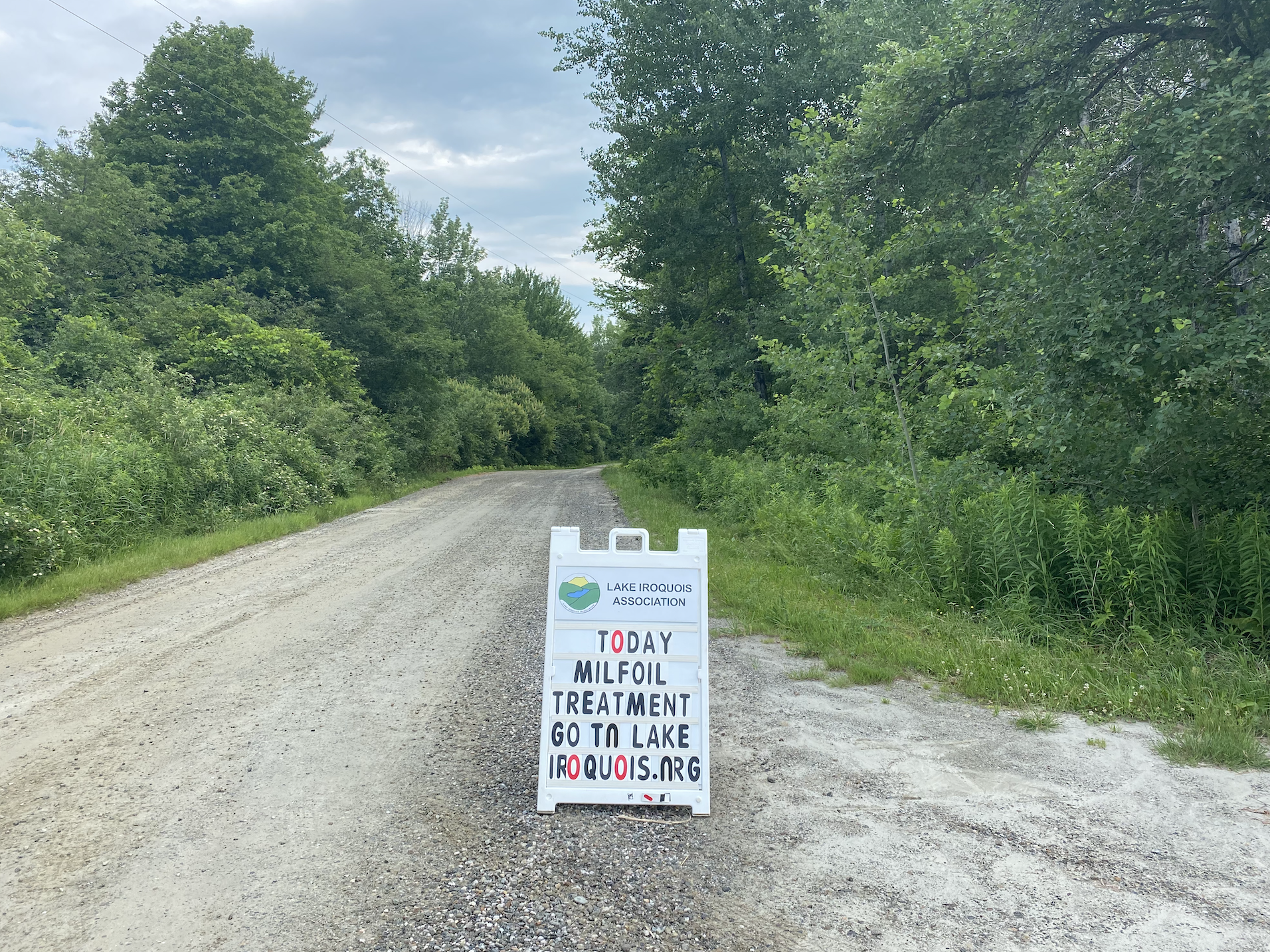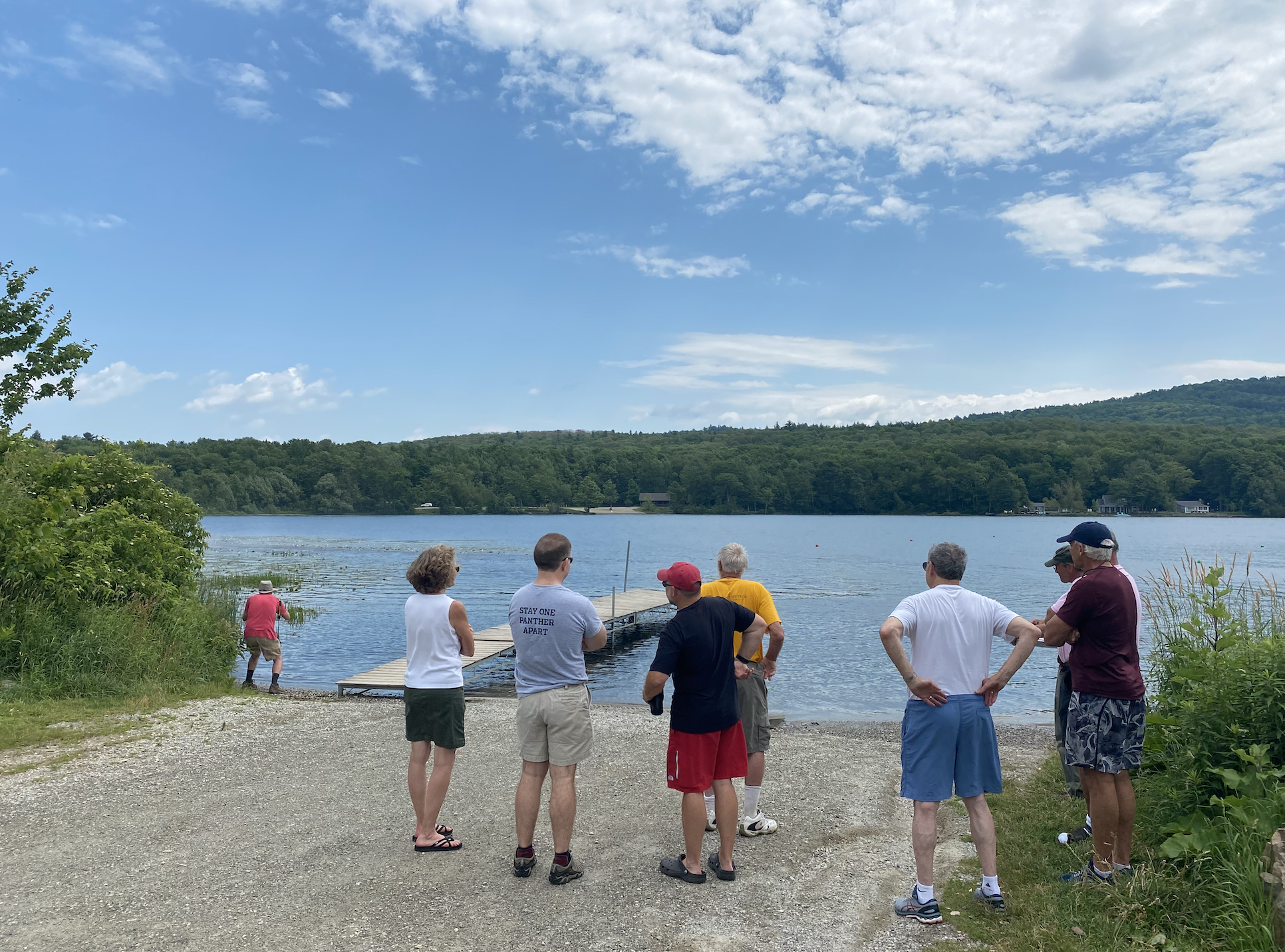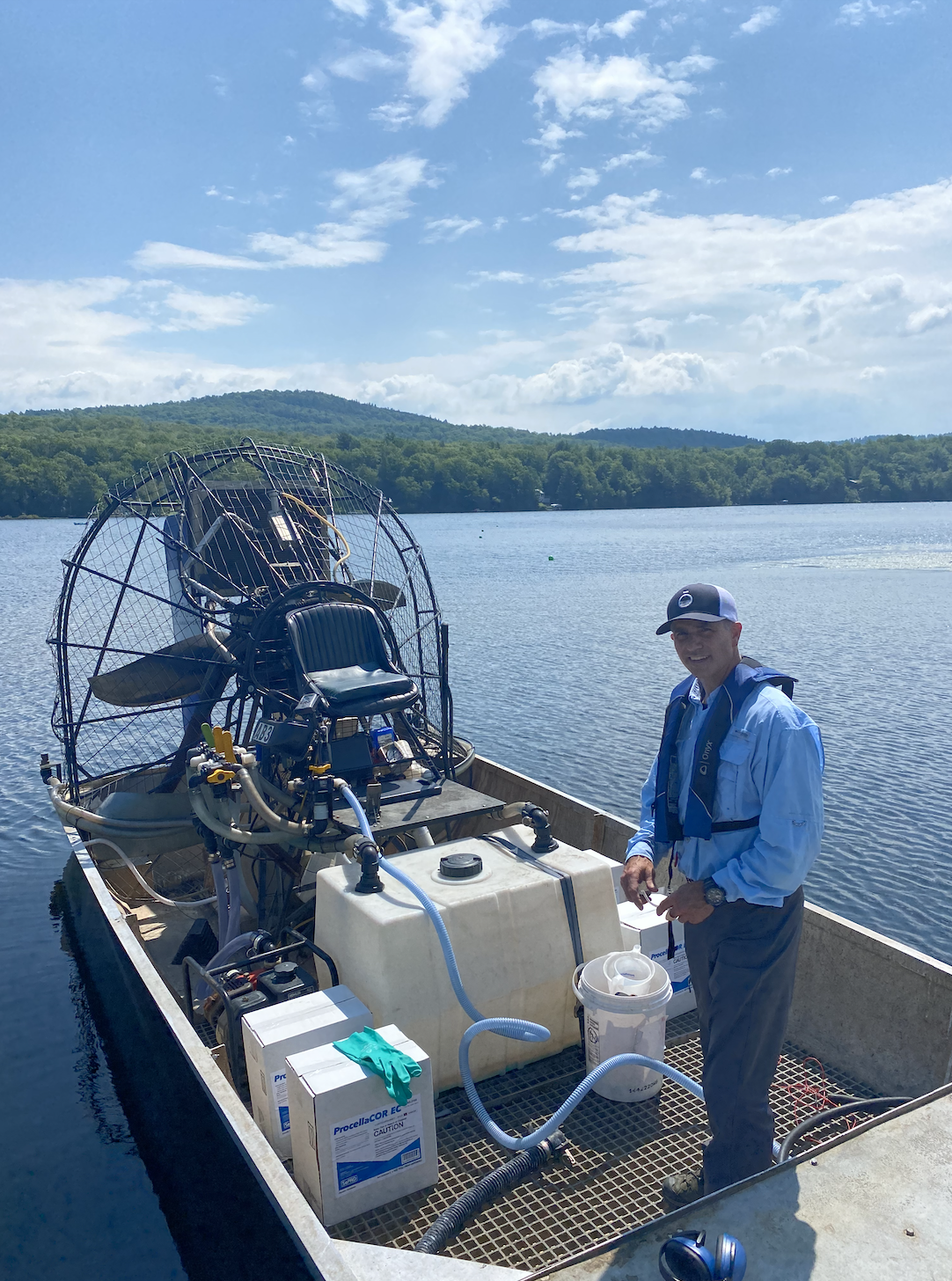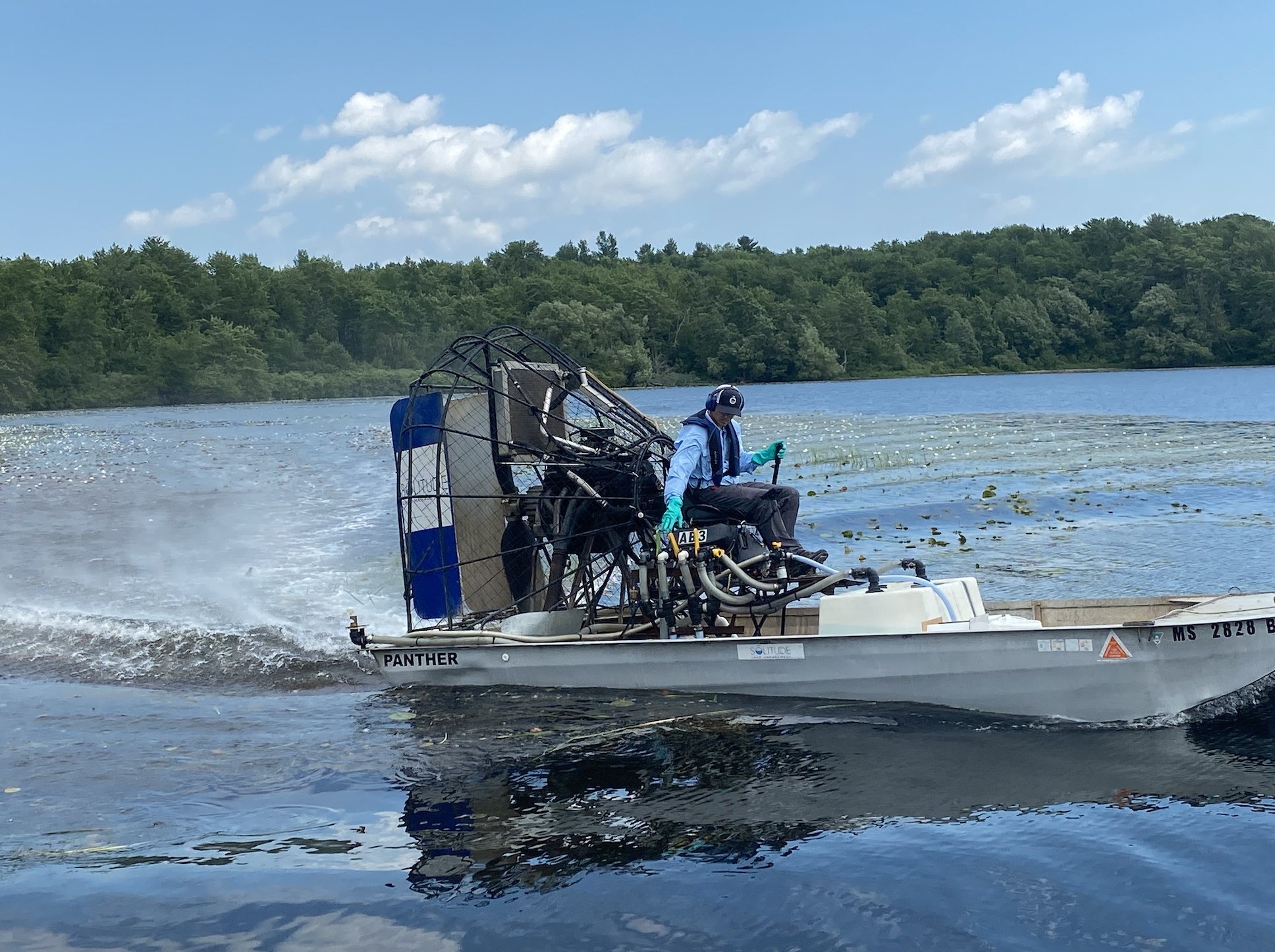Herbicide treatment to kill milfoil in Lake Iroquois 7 years in the making






Milfoil — an invasive water-weed that forms dense mats of vegetation and readily reproduces when boats chop up the strands — may soon be tamed in Lake Iroquois after recent treatment with an herbicide.
On June 28, members of the Lake Iroquois Association (LIA) gathered at the lake’s boat launch to watch and celebrate the herbicide application that was seven years in the making.
Eurasian Watermilfoil has invaded Lake Iroquois for decades, with evidence tracing back to the 1990s. By 2014, the scale of the infestation had been steadily increasing, and the LIA began to research options, undertake a full lake plant survey, and develop an action plan, says former LIA president Pat Suozzi. Since early 2014, the LIA has collaborated with The Lake Iroquois Recreation District to combat the plant.
In March 2020, the two groups filed a permit request to treat Lake Iroquois with the chemical herbicide ProcellaCOR. The request was approved this past February by the Department of Environmental Conservation (DEC). An earlier, 2018 application for a different herbicide was denied.
Obtaining the permit was a slow and challenging process, association members said.
After ProcellaCOR was cleared by the state, it was scheduled to be administered to Lake Iroquois in June of 2021. Prior applications suggest that the herbicide will effectively last for two to three years, and the permit requires an annual renewal, which must be refiled with the DEC.
The herbicide was administered by Marc Bellaud, the president of SOLitude Lake Management, an environmental firm based out of Massachusetts. The process took just under two hours.
Bellaud used an airboat, a specialized craft engineered to perform the treatment, said Bellaud as he boarded the vessel.
“The system pulls water in from the lake, into this tank, and then the herbicide gets diluted in with the lake water, and then with those valves over there you can change the flow and end up sending the product back out through hoses that come out the back of the boat under the water,” said Bellaud. “There’s no aerial spray, everything’s just injected subsurface.”
Once the herbicide is injected, the millfoil will quickly absorb the product and shut down almost immediately, Bellaud said. Over the course of the next two to three weeks, the milfoil will begin to collapse and decompose at the bottom of the lake.
The airboat is utilized for this task because there is no propeller in the water that destroys the milfoil, which would be a disturbance to the treatment process.
In the week following the treatment, the lake will be sampled for residual concentrations of milfoil. Later in the summer, the lake will be surveyed to evaluate the success of the treatment, said Bellaud. These surveys will be conducted by Waite-Heindel, an environmental firm based in
Burlington.
ProcellaCOR is an Environmental Protection Agency and State registered product that is specific to aquatic plants.
“It’s been pretty rigorously tested. We’ve used it quite a bit in Vermont already, I think it’s only had its full EPA registration since, either 2018 or 19, but it went through the reduced risk protocol with EPA,” said Bellaud.
A handful of lakes in Vermont have been treated with the same herbicide, including Lake Courtonia in Rutland, Lake Dunmore in Addison County, and Lake Pinneo in Quechee, said Bellaud.
“We’ve had an amazing track record with it since it came out, and I think the fact that it’s a reduced risk product with EPA gives people a lot of confidence. It is a pretty safe product for wildlife and humans,” said Bellaud.
Pat Suozzi, former LIA president, reinforced the safety of using ProcellaCOR.
“It’s targeted narrowly to milfoil and it's been shown to be non toxic to wildlife, in fact, there are no restrictions from the State Department of Health or The Department of Agriculture. They found no toxicity, it does not bioaccumulate, and it is not carcinogenic,” said Suozzi. “So we don’t expect to see any effect at all on wildlife and the lakes that’ve been used over the last couple of years in Ve rmont have seen no effect,” said Suozzi.
Jack Linn, a Richmond resident since ‘78 and an LIA member shared his love for the wildlife at the lake, especially loons.
“There are only 90 nesting pairs in the state of Vermont,” said Linn. “They are an indicator of a healthy lake, you can’t have loons and have an unhealthy lake,” he said.
Linn said that this is the third year that loons have nested at Lake Iroquois, and that the herbicide will help expand the fish population by creating more space, which will indirectly protect the loons, who need fish.
“I’m pretty excited that we are finally moving forward and really doing something that’s really going to make a difference,” said Suozzi, as she watched the airboat loop around the lake.
In 2016 and 2018, the LIA attempted a method where divers manually pull out the milfoil by its roots and feed it into a suction tube to reduce its concentration near heavily trafficked boating areas. This approach is far less effective, said Suozzi.
“It’s taken us seven years to get to this point, I started working on this project in 2014. I mean, we began the research, we began the plant surveys, and we began fundraising about five years ago and asking for donations,” said Suozzi. “Everything that we’ve done it’s been done totally by volunteers and volunteer hours.”
Suozzi said that the total cost of the herbicide application project landed somewhere between 55,000 and 60,000 dollars, a sum that was accumulated solely through fundraising. The success of their efforts was made possible by current LIA president Chris Conant, who with the help of his colleague Ernie Rossie, went door to door all around the lake, visiting Richmond, St. George, Williston and Hinesburg to collect donations from property owners.
“It’s been an amazing process. We appreciate the process, but it’s really been a long haul,” says Conant.
As their long-awaited milfoil control efforts come into fruition, the LIA has their sights on new projects to maintain Lake Iroquois.
The LIA recently received grant funding from the Lake Champlain Basin program to do a watershed action plan, where they will work together with the Lewis Creek Association as well as the Winooski Natural Resources Council to study the watershed of the lake and develop plans for the future, said Suozzi.
The kickoff meeting for this project will be held on July 6, 2021.
To view published article in the Hinesburg Record, click here.






